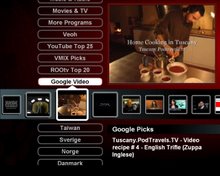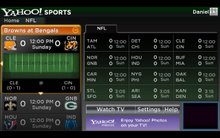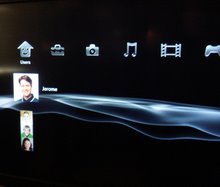Active-TV Ecosystem Developers,
The Issue: enabling TV interactivity via low-cost networked-STB technology.
Background: combing network access with STB MHEG-5 standard, improves support for interactivity.
Behind the scene: active-TV technology is similarly low-cost, but offers more advanced TV interactivity and access to networked-delivered TV-web video.
Contained in the S&T press release, is some interesting MHEG-5 and TV interactivity news.
S&T’s supply the tools needed to build carousel-style TV interactivity. The interactive material (the “broadcast file system”) is sent to the Set-Top Box in the MPEG2 transport stream. S&T also supply their RedKey MHEG-5 STB middleware; which seems currently supported by ST, ARM and possibly Zoran STB solutions.
A TV EPG (electronic program guide) is a typical MHEG-5 application. However, somewhat more advanced applications are possible, giving the TV user a limited amount of interactivity. Without an on-line return path, typically phone SMS based methods are used to complete any additional transactions.
A networked STB with RedKey MHEG-5 middleware can extend access from the “broadcast file system” to the “networked file system”. This improves its ability to support MHEG-5 compliant applications. The IP network eliminates the use of SMS for return path transactions.
MHEG-5 platforms are generally much less expensive than MHP (or OCAP) alternatives – which also typically have no return path. Given consumes’ rapid acceptance of broadband ISP service at home, this simple return path mechanism and expansion of MHEG-5 applications, may give these relatively low-cost STBs further market acceptance.
The RedKey middleware does not give the TV or STB, conventional access to the internet. The method does improve a STBs standalone capability, but MPEG-5 applications can not compete in complexity with active-TV technology’s PC-assisted applications. The STB also does not network with any home PC or notebook PC, enabling sharing of content.
Presumably, the interactive MHEG-5 STB can connect to the home router via wireless network support. I suggest consumers, would clearly appreciate wireless connection and interaction with the home laptop PC. At which point, support for TV-web channel applications, in advance of the more basic MHEG-5 applications, would be a much appreciated addition and add little to the cost of the STB.
Without this enhancement, the networked MHEG-5 STB does not allow the TV viewer to reach the increasing number of interesting TV-web channels. These “channels” give the TV user the freedom to access and share internet video and PC-resident content; A freedom, familiar to the PC user when accessing PC-web.
Feedback, corrections and comments welcome.
Navigate YouTube available at iTunes App Sore
An easy to use iPhone and iPod touch App that enables both new and advanced YouTube users to get the best from YouTube.
Browse video Standard Feeds, Categories, Channels and Playlists. Then organize new videos into your own favorites and playlists. Make playlists private or public. Subscribe to other user's playlists and video collections for future viewing. Subscribe to videos matching search-words.
Look at publicly viewable favorite videos, playlists and subscriptions based on your YouTube friends, family and contacts. Send and receive video links with YouTube contacts via YouTube video messages.
Search for new videos tagged for your language or geographical region, using local keyboard. Explore for new videos via easy switching of user ID to the owner of interesting videos - then explore their world.
All actions are kept in sync with PC, Mac or Apple-TV access to YouTube. Available at Apple App Store.
Browse video Standard Feeds, Categories, Channels and Playlists. Then organize new videos into your own favorites and playlists. Make playlists private or public. Subscribe to other user's playlists and video collections for future viewing. Subscribe to videos matching search-words.
Search for new videos tagged for your language or geographical region, using local keyboard. Explore for new videos via easy switching of user ID to the owner of interesting videos - then explore their world.
All actions are kept in sync with PC, Mac or Apple-TV access to YouTube. Available at Apple App Store.
active-TV technology for PC

Windows PC based home network
Subscribe to:
Post Comments (Atom)










No comments:
Post a Comment